Events and excursions, Summer 2023
Lowdham Village, 19th May 2023
The Parish church of St Mary’s and the preserved Signal Box
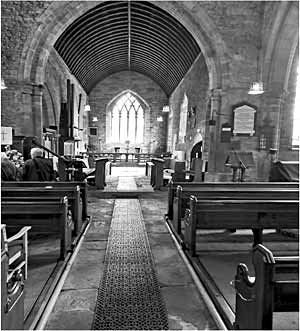 St Mary's church, Lowdham (photograph by Paul Baker)
St Mary's church, Lowdham (photograph by Paul Baker)Investigation into the history of Thoroton Excursions showed that Lowdham village had never been visited. The village is home to an interesting parish church, St Mary’s, and a preserved signal box rescued from demolition by a dedicated group of railway enthusiasts. A small group of Thoroton members were taken by coach to Lowdham from Nottingham Forest Park and Ride and Mount Street as usual but this year, there was the added risk of having a parking charge imposed if parking was not followed by riding. Members were able to avoid this levy.
We started the day by visiting the parish church of St Mary the Virgin, where we were met by David, the Reader and our tour guide, Joanne, who is also one of the guides at Southwell Minster. Joanne gave us a very interesting tour with a description of the church from almost 1000 years ago. It is not mentioned in Domesday but by 1154 had been given to Thurgarton Priory during the Anarchy for the health of King Stephen and the soul of his son who had died in 1153.
The first church was made of wood then a tower of stone was built in 1170 as a separate building. The mouldings at the base go all around the tower which would not have been seen as necessary if the tower was attached to the nave. The stone chancel was built in the 13th century with the wooden nave replaced by stone later in the century at a time of plenty and prosperity. The architectural style of St Mary’s is a transition between Romanesque and Early English Gothic. Graffiti on the porch were pointed out and described to us. Unfortunately, the key to the original porch door could not be found so we looked from the outside. Joanne described how the porch was used for ceremonies such as Churching of women after giving birth, a procedure of cleansing luckily now defunct. The internal door is original to the date of the nave. Tip ends of bolts could be seen which had been hammered into the door as added protection in case of attack with axes.
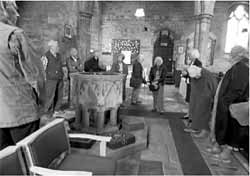 Font in St Mary's church, Lowdham
Font in St Mary's church, LowdhamThe font was pointed out as the best example of its date in the country with a carved head. The design is full of symbolism. It has 8 sides to designate the Octave of Easter and an equilateral triangle will fit inside. The style is reminiscent of the Chapter House in Southwell Minster and there was speculation among members that the same craftsman had carved St Mary's font. The church was renovated in the 1860s during the Gothic Revival by Gilbert Scott which included Victorian underfloor heating like a Roman hypocaust. From St Mary’s, members had the opportunity to follow the Lowdham Walking Trail, part of which goes past the site of Lowdham castle, now in a private garden but the mound can be seen from the footpath. Information boards, (see photograph on the next page), illustrating the Walking Trail had been erected by the Parish Council,Lowdham Local history Society and Friends of Burton Joyce and Lowdham Station next to the church, the Village Hall and the signal box, highlighting places of interest. After time for a stroll along the Walking Trail and lunch at one of the several pubs and restaurants in the village, members congregated at the signal box by the station.
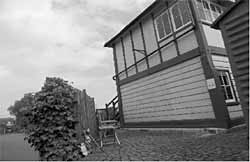 Lowdham Signal Box
Lowdham Signal BoxThe signal box was moved from its original location after it was taken out of use when signalling along the Nottingham to Lincoln line was modernised. A group of enthusiasts had raised money to buy it and move it to its present location in the garden of what was the station master’s house and goods yard.
It is now preserved as a museum and run by a charity, Lowdham Railway Heritage. Our tour guide was David who is also the Reader at St Mary’s. David described how railway signalling worked and what part the signal box played in a complex system that included the local Colwick marshalling yard that was the trigger for the development of Netherfield as the Railway Village in the late 19th century.
Lowdham Railway Heritage runs several Open Days during the summer including evening visits. More information about what the charity does and dates for open days can be found on their Facebook page, Lowdham Railway Heritage.
Ruth Strong
Tattershall Castle 22nd June 2023
Tattershall Castle and the Collegiate Church
(Two appreciations from Paul Baker and Kevin Powell)
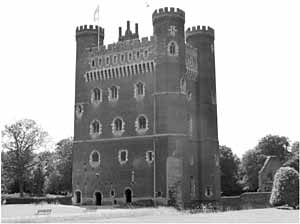 Tattershall Castle (photograph by Ruth Strong)
Tattershall Castle (photograph by Ruth Strong)Tattershall is one of the finest brick-built structures of the 15th century. Built by Ralph. Lord Cromwell, Henry Vl’s Lord Treasurer of England. It is an example of a castle where a tower was a fitting focus for a noble man that could be seen as a demonstration of power for the owner.
James Wright, our guide for the day, explained how it is one of the best examples of a castle built to reflect power and importance. James, who had written his doctoral thesis on “Tattershall Castle, Building a History”, as our guide, allowed us to see and consider the evidence that many visitors to the castle would miss.
After exploring the castle, a visit to the Collegiate Church of the Holy Trinity, adjacent to the castle, also built by Lord Cromwell, allowed us not only to get refreshments but to have a guided history of the church. This church was originally planned to be part of a trio of buildings with the castle and a college. Once again an interesting finish to a very successful excursion.
Thank you to Ruth Strong and James Wright for a splendid day out for Thoroton Society members.
Paul Baker
Tattershall Castle
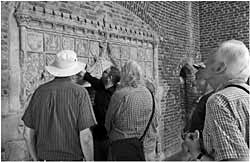 James Wright deciphering for members at one of the fireplaces (photograph by Paul Baker)
James Wright deciphering for members at one of the fireplaces (photograph by Paul Baker)The visit to Tattershall Castle was a great success - the building is spectacular as it towers over the level countryside of Lincolnshire. It must have been an awe-inspiring sight in days gone by. Our visit was blessed with excellent weather, with clear blue skies allowing almost uninterrupted views from the roof; here, there are information boards showing you what to look out for on the horizon. The warm sunshine allowed extensive views, enabling you to locate various landmarks across the countryside below.
As members climbed the staircases taking you up to the various floors of the castle, the descriptions which James Wright had given us became clearer the higher we climbed. On each level, it was easy to take in the surroundings of each room, particularly the stained glass windows which showed various coats of arms, featuring individual names and various dates. However, on closer examination, the dates did not seem to be related to the person mentioned, either in terms of their date of birth or death, nor (in the case of monarchs) of their reign. However, on speaking to one of the National Trust guides, I was informed that the stained glass was installed by Lord Curzon of Kedleston, after he saved the property and undertook the restoration of the castle between 1911 and 1914. He later purchased the property and, on his death in 1925, it was gifted to the National Trust. It turns out that the dates in the windows indicate the period in which the person owned or was connected with the castle. The oldest dates (which go back to 1066) are visible on the top floor, but as you descend from floor to floor, each storey reflects names and dates from different periods in the life of the Castle, especially during the Wars of the Roses. Thanks to all those who arranged a successful and enjoyable visit.
Kevin Powell
Papplewick Pumping Station and Bilsthorpe Heritage Museum 12th July 2023
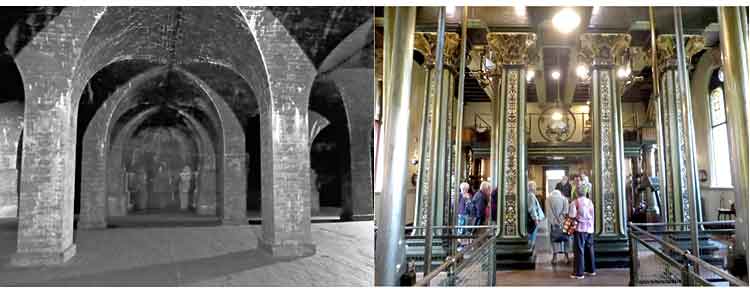
The underground reservoir (left) and interior of the boiler house (right) at Papplewick Pumping Station (photographs by Ruth Strong)
A bright and sunny morning saw the departure of the coach taking members to Papplewick Pumping Station for the first part of the day’s excursion. Upon arrival we were met by the Director, Ashley, and our first tour guide John who took us around the outside features of the Pumping Station. A plaque inside the Pumping house reminds us of a connection to the Thoroton Society.
John took the group around the lake which was used as a cooling pond for the pumping equipment while he recounted the history of the building. Papplewick Pumping Station was built between 1881 and 1886 as part of Nottingham Corporation’s scheme to supply clean water to the burgeoning industry and population of Nottingham. Until then, water had been drawn from rivers and was becoming increasingly polluted. John described how the Pumping Station was built over a deep well, 200 feet deep and 15 feet wide. The original Pumping station is not used now and John pointed out the new building across the lake which looks like a small modern bungalow. The grounds also have cottages built for the original workers so that they could be on site to cope with weather changes. Essentially the pumping engines were built into the foundations then the rest of the building was erected around it including a 120 feet high chimney, which was high enough to draw cool air under the boiler fire bed to improve combustion. John pointed out a green metal feature and asked for guesses as to purpose. It turned out to be an air vessel. Other buildings on the site included a blacksmith’s shop, engineer’s stores and a hayloft. Coal for the steam engines was delivered by horse drawn transport from Linby colliery but now comes from Indonesia. The quality is not critical. A high carbon content is best.
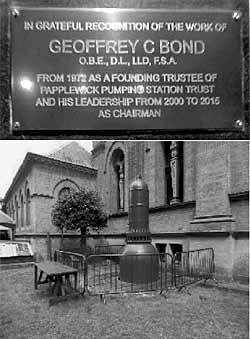
Inside the boiler house, our new guide Nigel, took over from John and told us all about the boilers, only two are now kept in use. Those have to be rigorously inspected every 10 years. The boilers have a brick casing which has to be dismantled for inspection, then the original bricks are re-laid. Originally there were six boilers used in succession, 2 cooling, 2 cold for cleaning and 2 warming up after cleaning. The pumping house is built over the wellhead and was able to pump 1% million gallons of water per day. The architecture is typical Victorian in that it is highly and beautifully decorated, even the ceiling bosses in the boiler house. The designs covering the supports reflect the purpose of the building showing fish, water plants and birds. Nigel, explained how the Pumping Station worked and showed us in the maps and photographs exhibited there, the extensive water supply system of Nottingham overseen by the great Thomas Hawksley. Fortunately, we were taken to the underground reservoir by trailer. It was at a good distance and higher elevation at 480 feet above sea level from the Pumping Station but well worth visiting. It is a vast underground space, waterproofed by a layer of puddle clay under brick. The method used to monitor and control water supply was described. In 1912, a crack was found. Tester bricks were inserted to measure further damage if it occurred. After a second crack was discovered and the first crack had visibly grown, the reservoir was shut down. It was thought to be too expensive to repair. The bricks used were all made locally; some still had the maker's name visible.
The group left Papplewick and went on to Blidworth for lunch at the Black Bull. After lunch, the coach took us to Bilsthorpe Heritage Museum. The site of the museum is easy to miss as it is at the side of the Village Hall. Originally, this small museum was to exhibit artefacts from Bilsthorpe Colliery after closure which reflect the development of a deep mine with the equipment used. Since then, it has amassed exhibits from other places in the Nottinghamshire coalfield, some everyday objects that some members recognised as using. The exhibits include a comprehensive collection of commemorative plates from every colliery, mine rescue equipment and other tools used for mining. There were scale models of the larger machines used for coal cutting; some very like those used for boring tunnels for the Underground and recent projects. There were plenty of volunteers available to talk to us about all the exhibits and to explain their use and significance. Outside there is a memorial garden for those miners killed in mining accidents, illustrating the price paid in the mining of coal. The museum depends on donations and a small shop. The museum volunteers were happy to let members stay as long as they wished but soon it was time to rejoin the coach for the return to Nottingham.
Ruth Strong